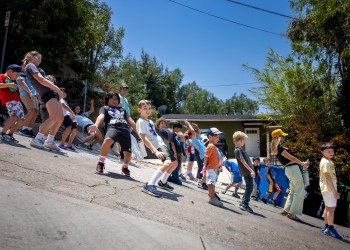The many thousands who regularly use the state’s large and varied park system were among the most distraught of Californians when legislators and Gov. Jerry Brown last year imposed cuts and closures on the system, with 70 parks scheduled for shuttering early this summer.
Some of those closures will come right on schedule, but not all. Where parks fended off mothballing, it’s been in large part because of rare partnerships riding to the rescue, some involving cities and other government agencies, others depending on private foundations and donors.
Among the saved parks is the Colusa-Sacramento River State Recreation Area, spared the shutdown ax for at least five years by a new operating agreement with the city of Colusa. The National Park Service stepped in to keep three Northern California parks open at least through this year, including Del Norte Coast Redwoods State Park and the Tomales Bay and Samuel P. Taylor parks adjacent to Pt. Reyes National Seashore.
The Los Encinos State Historic Park in the San Fernando Valley portion of Los Angeles survives for at least a year because of an anonymous gift and the Henry W. Coe State Park northeast of Gilroy stays open three years because the private, nonprofit Coe Park Preservation Fund will kick in $300,000 per year.
One salient point stands out as these state parks (and there will likely be more such arrangements before the closures are due to occur) are spared from the budget ax that’s killing many curriculum offerings and increasing class sizes in schools from kindergarten to the college level, the same ax that threatens adult day care centers and the staffing of police and fire departments:
The state park system took a cut of $22 million in the latest budget. Compared with the $1.4 billion that elementary and high schools have lost in the past two years, it’s a mere drop in the bucket. A sum like that has a big impact in parks mostly because the largest expense by far in parks usually comes when land is acquired. Money for park administration, where staff is spread thinly and there are relatively few maintenance and capital expenses, is just not as big as in other state programs. So grants from cities and foundations that amount to thousands of dollars – not millions – can have an impact.
But when it comes to schools and social services, much more intensively staffed, grants of that size would be a drop in the bucket. It would take many millions to make restorations similar to what the donations are doing for some parks.
Yes, cities in many parts of California pitch millions in for their local schools, and it makes a difference when they do that. Municipal money, for example, is one reason schools in cities like Palo Alto and Beverly Hills perform far above average. Private foundations also help out in some places.
But there are no such foundations to support in-home health care for the frail elderly. As a result, the cuts made last year may send thousands of them to nursing homes, where their care will cost government more in the long run, while also putting experienced caregivers out of work.
The same for prisons, where shifts of low-risk inmates to county jails and then to parole has cut budgets by more than $2 billion over the past two years. Don’t expect any foundations, private donors or nearby cities to step up with money to help restore those cuts. One reason: Prison users (read: convicts) don’t contribute to the local economy the way visitors to state parks often do when they buy lodging, food, souvenirs, gasoline and other services.
There is no doubt the idea of state park partnerships – first proposed 15 months ago by Republican state Sen. Sam Blakeslee of San Luis Obispo – is working well for at least 10 percent to 15 percent of the parks chosen for closure.
It’s an idea that can work when relatively little money is needed to keep a park or program going, but of little or no use in helping out the big-money services that eat up most California tax dollars.


























